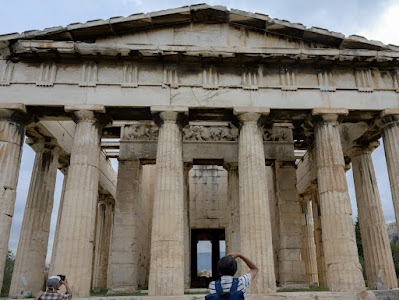Chicago, day 1, along the Magnificent Mile
A short walk up South Michigan Avenue takes you from Millennium Park to the Chicago River and a clutch of exciting buildings. On our way I took yet another picture of the elevated track of the 'L' Line.
We passed the twin towers of Marina City and then the rather impressive Jewellers Building, built in 1924 to the design of Thielbar and Fugard, based on the 15-century chapel for the Certosa of Pavla, an Italian monastery. It originally had a parking area inside to allow jewellery to be driven straight in, so as to avoid robberies, but this has since been converted to office space.
By now the afternoon was drawing on and the light was growing warmer. We passed the Church of Christ Scientist, a nice rounded design by Harry Weese, 1968, and moved up river towards the lake passing the IBM building and the Trump International Hotel and Tower. Chicago being Chicago tried to resist Trump's name being plastered over the front of it, but as there was no legal impediment the lettering went ahead. This building was redesigned several times before it was built. Finally the architects, Skidmore, Owings and Merrill, presented a design which mirrored the set backs of earlier Chicago high buildings and had these placed so that they lined up with the structures around it. It was completed in 2009.
The building to the left of Trump Tower in the 3rd, 4th and 5th picture down is the IBM Building, the last structure designed by Mies van der Rohe before he died in 1969.
These buildings, down to Pioneer Court and the Chicago tribune Tower lie along the 'Magnificent Mile', well named.
Finally we were crossing the Michigan Avenue Bridge to Pioneer Court and the iconic Wrigley Building, flanked on it's right hand side in the photo below, by the Chicago Tribune Tower.
The Wrigley building consists of two towers linked by a lobby on the first floor and by a sky walk on an upper level. The clock tower was inspired by the Giralda Tower in Spain. The architect of both towers was the firm of Graham, Anderson, Probst and White, the south tower being erected in 1922 and the north in 1925. Both towers are sheathed in terracotta.
The broad plaza underneath the Wrigley building is Pioneer Court.
In the picture below the white building on the left is 333 North Michigan Avenue (1928). The curved building is the London Guarantee and Accident Building (1923). It is believed to be built over the site of the original first homestead on the Chicago River, the residence of Jean Baptiste Point du Sable. The Mather Tower directly behind it (1928) and the Jewelers Building (1926) to it's right.
Pioneer Court was also home to a giant statue (25ft) of Abraham Lincoln who stands next to a man holding a copy of the Gettysburg Address. It is a bronze, sculpted by Seward Johnson and titled 'Return Visit'. It was erected in time for the 2016 election and is planned to be in place during 2017.
The crane behind the statue is working on the site of the new Chicago Apple Store. The building behind the crane is the Equitable building (1965).
The last thing we did in this section was to visit the Chicago Tribune Tower which sits to the north of the Court. The Chicago Tribune in 1922 held a competition for the design of their new headquarters. The winners, Raymond, Hood and John Mead Howells, from New York presented a limestone tower with accoutrements in French Gothic cathedral style . Flying buttresses, gargoyles and gutters adorn the top of the tower, while some of the windows and doorways are also heavily ornamented.
Embedded in the lower walls are hunks of rock brought back by Tribune reporters, stolen from iconic locations around the world.
We went into the lobby where the walls are lined with speeches extolling the freedom of the press. So close to the US election of Donald Trump and his shinanigans, they certainly gave pause for thought.




































Comments
Post a Comment